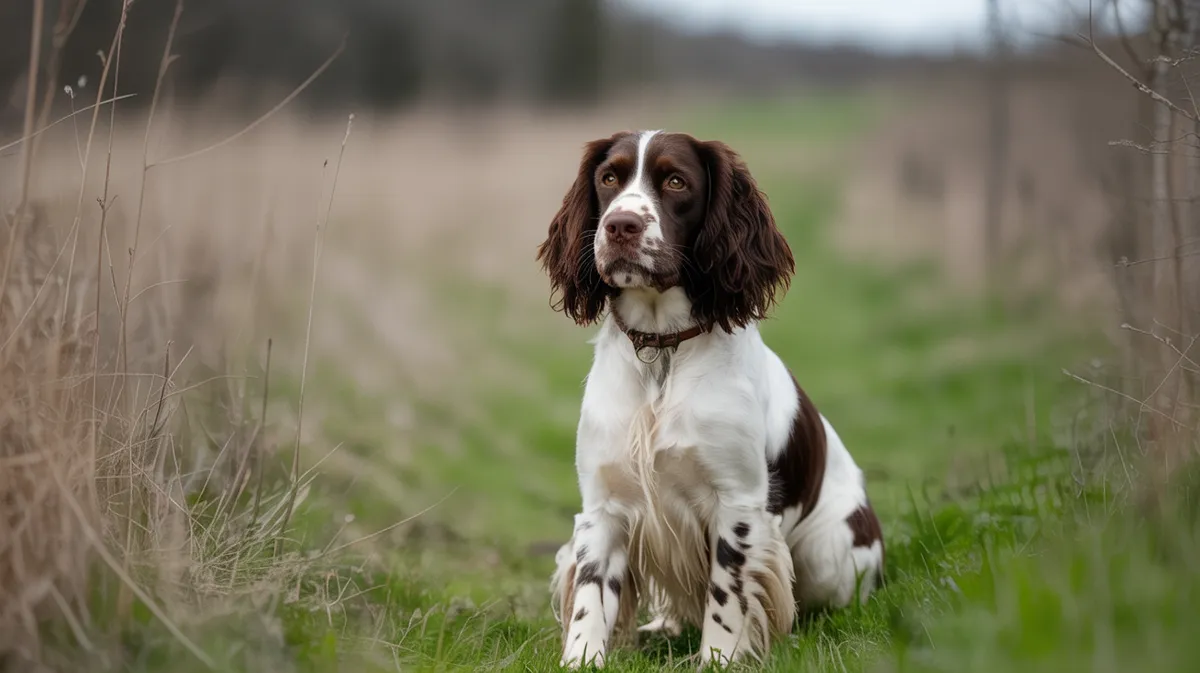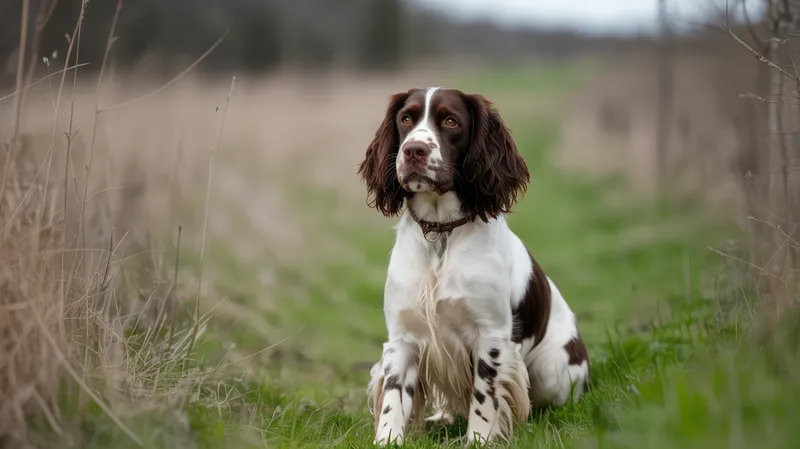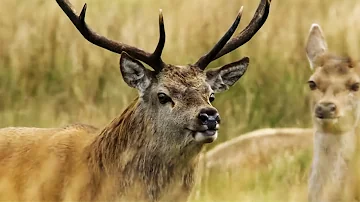
English Springer Spaniel
Canis lupus familiaris

Meet the English Springer Spaniel
The English Springer Spaniel is a medium-sized, athletic dog breed originally developed in England for flushing and retrieving game birds. Known for their friendly, eager-to-please temperament, these spaniels are highly intelligent and excel in various canine sports and as loyal family companions. Their distinctive, wavy coat and expressive eyes make them easily recognizable, and they require regular exercise and mental stimulation. English Springer Spaniels are also valued for their keen sense of smell and are often used in detection work by police and military forces.
Classification
Mammal
Habitat
Domestic environments, rural and suburban areas, and fields used for hunting
Diet
Omnivore
Lifespan
12-14 years
Conservation
Least Concern
Weight
18-25 kg (40-55 lbs)
📖Fascinating Facts
Versatile Working Dogs
English Springer Spaniels are prized for their versatility and are used in hunting, search and rescue, detection work, and as therapy dogs.
Loves Water
They have a natural affinity for water and are strong swimmers, often enjoying retrieving objects from lakes or rivers.
Exceptional Sense of Smell
Their keen sense of smell makes them outstanding detection dogs, capable of identifying explosives, drugs, or even lost persons.
📋Detailed Description
The English Springer Spaniel is a robust, medium-sized dog, typically weighing between 18–25 kg (40–55 lbs) and standing 48–56 cm (19–22 in) at the withers. It is characterized by a well-proportioned, athletic build, long, pendulous ears, and a moderately long, wavy or flat double coat that is water-resistant, aiding its function in wet field conditions. The breed’s expressive, almond-shaped eyes convey intelligence and alertness. English Springer Spaniels possess a deep chest for stamina, strong limbs for agility, and a tail traditionally docked in working lines to prevent injury in dense brush. Their olfactory system is highly developed, with a large nasal cavity and dense olfactory epithelium, enabling exceptional scent detection. Behaviorally, they are energetic, sociable, and eager to work, displaying strong trainability and a pronounced desire for human companionship. In the wild or field, they exhibit a characteristic quartering pattern, systematically sweeping terrain to locate and flush game. Socially, they are pack-oriented, thriving in both human families and canine groups, and are known for their gentle disposition with children and other animals. Reproductively, they are polyestrous, with females coming into heat twice yearly, and litters averaging 5–7 pups. Unique among spaniels, English Springers have been selectively bred into distinct show and working lines, with subtle differences in morphology and temperament tailored to their respective roles.
💡 Did you know?
English Springer Spaniels have been used as search-and-rescue dogs and are highly regarded for their ability to detect explosives and drugs.
🔬Research & Sources
Wikipedia Summary
The English Springer Spaniel is a breed of gun dog in the Spaniel group traditionally used for flushing and retrieving game. They are descended from the Norfolk or Shropshire Spaniels of the mid-19th century; the breed has diverged into separate show and working lines. It is closely related to the Welsh Springer Spaniel and very closely to the English Cocker Spaniel; less than a century ago, springers and cockers would come from the same litter. The smaller "cockers" were used in woodcock hunting while their larger littermates were used to flush, or "spring", other game birds. In 1902, The Kennel Club recognized the English Springer Spaniel as a distinct breed. They are used as sniffer dogs on a widespread basis.
Last Modified: 4/2/2025
🎭Behavior & Social Structure
English Springer Spaniels are highly active and require significant daily exercise, often thriving with 1–2 hours of vigorous activity per day. Their hunting behavior is defined by a methodical quartering gait, using their acute sense of smell to locate hidden birds or small mammals, then flushing them into the open for retrieval. They are natural retrievers, displaying a soft mouth and willingness to return game undamaged. Socially, they are affectionate, people-oriented, and generally non-aggressive, though they may exhibit alertness and vocalize when strangers approach. They excel in structured activities such as agility, obedience, and scent work, and are frequently employed as detection dogs in police and military contexts. Their daily routine typically includes bursts of high activity interspersed with periods of rest, and they often seek close physical proximity to their human companions. Playful and intelligent, they benefit from mental stimulation and consistent training.
👶Reproduction & Life Cycle
English Springer Spaniels reach sexual maturity around 6–12 months, with females experiencing estrus cycles approximately every six months. Mating is typically preceded by courtship behaviors such as play-bowing, sniffing, and licking. Gestation lasts about 63 days, after which litters of 5–7 puppies are born, though litter size can range from 4 to 10. Neonates are altricial, requiring intensive maternal care; the dam nurses and cleans the pups, providing warmth and protection. Weaning begins at 3–4 weeks, and puppies are usually fully weaned by 6–8 weeks. Breeders often select for temperament, health, and working ability, with responsible breeding practices emphasizing genetic screening for inherited conditions such as hip dysplasia and progressive retinal atrophy. There is no strict breeding season, but most litters are planned for spring or early summer to facilitate outdoor rearing.
🛡️Adaptations & Survival
The English Springer Spaniel exhibits several adaptations for its traditional role as a gun dog. Its water-resistant double coat protects against cold and wet environments, while feathering on the legs and chest shields against underbrush. The breed’s strong, webbed feet facilitate movement through mud and water. Its acute olfactory abilities are supported by a large, moist nose and extensive olfactory epithelium, making it highly effective in scent detection. Behaviorally, the Springer’s high intelligence, eagerness to please, and strong work drive are products of selective breeding for trainability and cooperation. The breed’s stamina and agility allow it to cover large areas of rough terrain efficiently. Its soft mouth is an evolutionary specialization for retrieving game without causing damage.
📚Research Sources
🎨Cultural Significance
The English Springer Spaniel has played a significant role in British rural culture as a premier flushing and retrieving dog since the 19th century. It is celebrated in literature, art, and country sports, and is a fixture in field trials and working tests. The breed’s intelligence and trainability have made it a favorite in modern detection roles, including narcotics, explosives, and search-and-rescue work worldwide. In popular culture, the Springer is often depicted as the quintessential family and sporting dog, symbolizing loyalty, energy, and companionship. It has no major mythological or symbolic roles but is deeply embedded in the traditions of British and European hunting societies.
🔬Recent Research & Discoveries
Recent genetic studies have clarified the close relationship between English Springer Spaniels, English Cocker Spaniels, and Welsh Springer Spaniels, revealing shared ancestry and historical interbreeding. Ongoing research focuses on identifying genetic markers for inherited diseases, with advances in DNA testing improving breeding outcomes. Behavioral studies have examined the Springer’s suitability for detection work, highlighting its superior olfactory discrimination and trainability compared to other breeds. Veterinary research continues to address breed-specific health concerns, particularly orthopedic and ophthalmic conditions. Studies on working versus show lines have documented differences in morphology, behavior, and performance, informing breeding and training practices.
🎥Wildlife Videos

An introduction to English Springer Spaniel for hunting - Rosstulla Gundogs
HuntingDogs #EnglishSpringerSpaniel #GundogTraining Join us as we take a tour of Patrick Torrens' kennel at Rosstulla ...
CHASA - Conservation And Hunting Alliance of SA

The Value of English Springer Spaniels in Wildlife Conservation
The Value of English Springer Spaniels in Wildlife Conservation The Role of English Springer Spaniels in Wildlife Conservation ...
Spaniel (English Springer) USA

TRIALLING: A Spaniel's Journey - Broadcast Documentary
See below for link to full Broadcast Video: UK: https://www.amazon.co.uk/dp/B07BWRL22H USA: ...
[LoneHunter]

Exploring Britain’s Wild Animals: From Golden Eagles to Goshawks (3H Marathon)
Exploring the country's diverse landscapes and the wildlife that has adapted to survive in extreme environments, from Golden ...
Our World

3 Hours of The Untold Stories of British Wildlife | Our World
A wildlife documentary series, narrated by Hugh Bonneville, uncovering the hidden lives of animals across diverse habitats ...
Our World

Dog Rescuers: Incredible Transformations of Rescue Dogs - Animal Documentary
Meet a timid spaniel who was initially terrified of everything, from loud noises to unfamiliar environments, but learned to face the ...
Heavy Petting - Animal Documentaries
🌍Habitat Information
The English Springer Spaniel typically inhabits Domestic environments, rural and suburban areas, and fields used for hunting environments. English Springer Spaniels have adapted to their environments with specialized features and behaviors.
Primary Habitat:
Domestic environments, rural and suburban areas, and fields used for hunting
More detailed habitat information will be available soon.
🛡️Conservation Status
The English Springer Spaniel is currently classified as Least Concern. Conservation efforts are crucial for preserving this species for future generations.
Common Threats:
- 🏠Habitat loss and fragmentation
- 🌡️Climate change impacts
- 🎯Hunting and poaching
- 🏭Human-wildlife conflict
⚠️Threats & Conservation Challenges
As a domestic breed, the English Springer Spaniel is not threatened in the wild and is classified as 'Least Concern.' However, the breed faces challenges related to inherited health conditions, including hip and elbow dysplasia, ear infections due to pendulous ears, and genetic eye disorders such as progressive retinal atrophy. Overbreeding and irresponsible breeding practices can exacerbate these issues. In working contexts, the breed may be exposed to physical hazards such as thorny vegetation, waterborne pathogens, and injuries from rough terrain. Population trends are stable, with the breed remaining popular as both a companion and working dog. Conservation challenges primarily involve maintaining genetic diversity and health through responsible breeding.
🔬Scientific Classification
Scientific Name
Canis lupus familiaris
Classification Hierarchy
🔍 About Taxonomic Classification
Taxonomic classification is a hierarchical system used by scientists to classify and organize living organisms based on shared characteristics and evolutionary relationships.
The system moves from broad categories (Kingdom) to increasingly specific ones, with each animal's scientific name typically consisting of its Genus and species.
📝Community Notes
Share your observations and insights about the English Springer Spaniel with our community of wildlife enthusiasts.
Join Our Community
Sign in to share your observations and connect with fellow wildlife enthusiasts.
Sign In to ContributeNo community notes yet
Be the first to share your observations about the English Springer Spaniel!
Explore English Springer Spaniel
Select a tab above to learn more about this amazing animal.
📸Photo Gallery
No photos available for this animal yet.
🌟Discover More Wildlife
Continue your journey of discovery with more fascinating animals from our database
